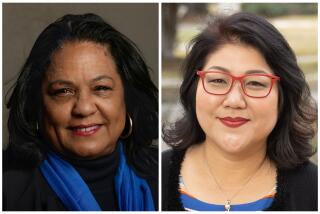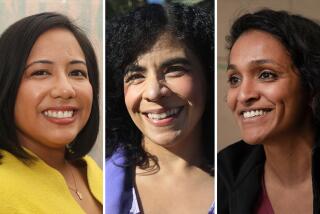Mayor candidates on transportation: innovation vs. tried and true
During eight years in office, Los Angeles Mayor Antonio Villaraigosa staked much of his legacy on transportation. He lobbied Washington for millions of dollars in federal funding. He oversaw the addition of 150 miles of bike lanes. And, five years ago, he won voter approval of Measure R, the countywide half-cent sales tax expected to raise more than $30 billion over 30 years for a dozen new transportation projects.
The challenge for the next mayor, experts say, will be the nuts and bolts: repaving the cityâs broken streets and sidewalks, completing a surge of bus and rail projects and securing more transportation funding.
Mayoral contenders Wendy Greuel and Eric Garcetti view transportation much like Villaraigosa, as a key cog in the machinery of a well-planned city. Each has supported a combination of bus and rail service, more economic development near transit hubs and more safeguards for bicycles and pedestrians. Both favor a Westside subway that would run under parts of the Beverly Hills High School campus and more transit options through the Sepulveda Pass.
But there are notable differences, experts say, in the candidatesâ approaches to transportation problem solving.
âEric is creative and innovative,â said Frank Zerunyan, a public policy professor at USC who has not publicly supported either candidate. âWendy wants to know what will work.â
A key challenge for the new mayor will be influencing decisions on the countywide Metropolitan Transportation Authority board. Neither Greuel nor Garcetti has served on the panel. The cityâs voting bloc often has been at odds with county representatives, who argue big rail projects do little to help other cities in the region.
Among likely L.A. city voters in Tuesdayâs election, nearly half said they thought policymakers should focus on public transportation, compared with 35% who favored spending on roads and freeways, according to a new poll by the USC Sol Price School of Public Policy and the Los Angeles Times.
More respondents â 38% â said Garcetti has a plan to address the cityâs transportation problems, compared with 26% for Greuel. But 11% said neither had a plan and 19% didnât know. Six percent rated both candidates about the same on the question.
One measure of the new mayor, UCLA professor Martin Wachs said, will be whether she or he can find common ground on priorities with powerful county supervisors and finish big transit projects without having to incur more public debt.
âThe most important thing either will do, ultimately, is make appointments to the Metro board,â Wachs said. In addition to the seat held by the mayor, L.A.âs elected chief executive appoints three board members.
Zerunyan, a Greuel acquaintance, said she brings a âboardroom mentalityâ acquired while working in government and community affairs at DreamWorks.
Greuelâs former City Council transportation deputy, Jennifer Cohen, said that when her boss was chairwoman of the councilâs transportation committee she listened to a wide range of groups and favored practical solutions to problems like congestion and pedestrian safety. She still emphasizes such programs as left-turn signals, filling potholes and imposing a ban on construction during rush hour.
To save money on street repairs, she suggested requiring the city to repave the streets rather than contracting out the work to private firms. She has proposed reviving a fast-track sidewalk repair program under which the city and property owners split the costs. The project, canceled in 2009 because of cost, became so popular that applicants were being turned away.
Greuel supported bus-only lanes now being built on Wilshire Boulevard and was âa critical ally at a time when we needed allies,â said Sunyoung Yang of the Bus Riders Union.
Greuel â supported by Garcettiâ wrote a motion that helped clear the way for L.A. Countyâs new freeway toll lanes. Now, both candidates say they will support continuation and expansion of the lanes only if traffic flow has improved at the end of a one-year test period. Initial data for the 110 shows speeds in the non-toll lanes on the Harbor Freeway have slowed.
A plurality of likely L.A. voters, 39%, said traffic congestion is the cityâs most serious transportation problem, according to the USC Price/Times poll. But voters were evenly split on the new toll lanes, with 47% supporting and 47% opposed, according to the survey. More than half of voters â 58% â said they would be unwilling to pay the current tolls charged on the Harbor Freeway to reduce commute time.
Garcetti tends toward more creative fixes for the cityâs transportation problems, experts say. During one debate, he suggested a $1-million prize â perhaps funded by the private sector â for whomever provided the best solution to L.A.âs chronic congestion. Heâs also proposed high-tech âcar trainsâ that would control speeds of groups of vehicles and increase the capacity of the regionâs freeways.
As a council member, he urged the city to expand support for a car-sharing program, a pedestrian coordinator and the cityâs first bicycle-only lanes. âBicycling should not be an extreme sport,â Garcetti has often said. And heâs been a champion of denser mixed-use development near subway stations in Hollywood. Advocates say such âsmart growthâ helps reduce congestion by encouraging greater use of public transportation.
Both Greuel and Garcetti support extending a half-cent sales tax increase approved by voters in 2008 and lowering the threshold for passage of such measures from a two-thirds majority to 55% of the vote.
One controversial issue the new mayor could face is choosing a contractor for the proposed Crenshaw rail line, which would connect the Expo and Green lines. Both candidates have promised to fight for a station in Leimert Park, considered a hub of African American culture in Los Angeles.
Garcetti also has promised that his Metro board appointees would include a South Los Angeles representative and a transit rider. Greuel has been less specific, saying she would make sure âSouth Los Angeles voices are represented on the Metro board.â
Neither commitment is good enough, said Damien Goodmon of the Crenshaw Subway Coalition. âWe keep pressing for more specificity,â he said. âWhat will we see? Weâre close to the end, and no one is sure.â
More to Read
Sign up for Essential California
The most important California stories and recommendations in your inbox every morning.
You may occasionally receive promotional content from the Los Angeles Times.











